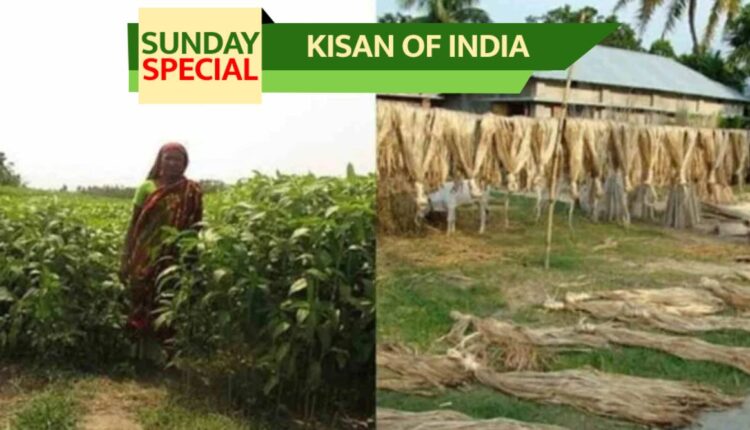Jute Farming: Why India is the largest Jute Producer?
There were attempts to grow jute in countries like America, Egypt, Brazil, Africa, but they could not stand in front of Indian jute.
Jute or jute is a cash crop. Jute is also called Jute or Patua. It is a fibrous product. India, Bangladesh, China, and Thailand are their main producing countries. More than half of the global production of jute is produced in India. Three-fourths of Indian jute is consumed in the country, and one-third of the production is imported by countries like the UK, Belgium, Germany, France, Italy, and the USA. There are immense possibilities in jute cultivation. Jute is in great demand in the packaging industry around the world, considering the environmental damage caused by plastic, as jute being an organic product, is easily degradable.
Jute farming is Labor Intensive
According to the National Jute Board, about 40 lakh farmers and 8 lakh hectares of land in the country are related to jute cultivation. Jute cultivation is labor intensive. It is a fiber crop grown in the Ganga delta. Among natural fibrous agricultural products, jute ranks second only to cotton. It is being cultivated in 83 districts of West Bengal, Assam, Odisha, Bihar, Uttar Pradesh, Tripura, and Meghalaya. West Bengal is the largest jute-producing state in the country and produces more than half of the total jute produced in the country.
Jute is the Oldest Agricultural Industry
Jute is also related to the oldest agro-industry in the country. The country’s first jute mill was started in Kolkata in 1855. There are 83 jute mills in the country, in which more than 1.6 million tonnes of jute or its products are produced annually. About 3 lakh people are getting direct employment from the jute industry. Jute exports earn the country about $4 million in foreign exchange. The Ministry of Agriculture is determined to expand jute cultivation to the maximum and increase its yield. This will increase the income opportunities for the artisans making jute products apart from the farmers.
Countless products are made from Jute
Traditionally, jute fibers have been used to make sacks, rugs, carpets, tents, tarpaulins, gunny bags, ropes, paper, decorative items, furniture and clothing, and countless other products from cotton. The biggest advantage of jute products is that they are durable and eco-friendly.
That is why the future of jute cultivation and industry is considered bright. ICAR-Central Research Institute for Jute & Allied Fibres, Barrackpore, is the premier jute research institute in the country, where many improved varieties of jute have been developed.
Sarees are also made from Jute
Keeping pace with the fashion, now sarees made of jute have also made their own market. In many parts of the country including Kolkata, weavers are making attractive sarees from jute fibre. Women are very fond of it, because apart from being fashionable, they are more durable. The fresh jute fiber is stronger, shinier and whiter.
This does not give a completely white fiber, because it can only be partially bleached. Sarees, tiles, jute handicraft products, bags, home textiles, gifting items and footwear made of jute blended fibers are now reaching common homes. Paper is made from the pulp of jute stalks. Jute charcoal has also been found to be excellent in making gunpowder.
Bengal at the forefront of Jute Cultivation
Jute is a Kharif crop. It needs hot and humid climate. For this, the climate with 21 to 38 degree Celsius and 90% relative humidity is very favorable. That’s why efforts were made to grow jute in many countries like America, Egypt, Brazil, Africa, but they could not stand in front of Indian jute. Jute cultivation is good in light sandy and loamy soils of the delta. That’s why the climate of Bengal is perfect for jute. August-September is the right season for its sowing. But it is also sown in March-April depending on the condition of the field and the variety of seed.
The stem of jute is thin and cylindrical. The crop is grown from jute seeds. Plants are allowed to ripen fully to obtain seeds, but they are harvested before ripening to obtain fine fibre. The crop is ready about four months after transplanting. It is harvested after the plants have flowered and before the flowers turn into seeds.
The stems are cut from the ground surface and sometimes uprooted along with the roots. Then by sprinkling its leaves and making bundles of stem stalks, they keep it immersed in water. This separates the jute fibers present in the stems, which are dried after washing in clean water.
Major Species and Varieties of Jute
There are two main species of jute – Capsularis and Oolitorius. The leaves of both are circular. capsularis is a bit tougher. It is planted in both high and low fields, while olitorius is cultivated only in high ground. The seeds of capsularis are dark brown in color and the fiber is white but slightly weak, while the seeds of olitorius are black in color and the fiber is beautiful, strong and dull white in color.
The varieties of capsularis are Fanduk, Ghaleshwari, Phuleshwari, Desihat, Bombay D 154 and R 85 while the varieties of olitorius are Desi, Tosah, Arthu and Chinsura Green. Of the total area under jute cultivation, Capsularis occupies three-fourth of the area, while Olitorius accounts for one-fourth of the area. The yield of capsularis is 4 to 6 quintals per acre and that of olitorius is 6 to 8 quintals per acre. Some of the early flowering jute varieties are JRO-525 (Naveen) and JRP-843.
Improved Method of Jute Cultivation
Sowing: Before sowing jute, the field should be well plowed. Its sowing is usually done by sprinkle method, although now the drill method is also becoming popular. Seed rate of 3 to 4.5 kg per acre is sufficient. There should be a distance of 10-15 cm for the seeds. After sowing, the crop needs 2 to 3 inches of rain every week.
Fertilizer: At the time of ploughing, 2 to 4 quintals of cow dung or compost and one and a half to two quintals of wood or grass ash or biochar and 20-25 kg of nitrogen should be used at the time of plowing for good yield. Half of the nitrogen should be applied before sowing and the rest after a week of seed germination. The use of potash and lime is also beneficial in jute cultivation.
Care:
Jute plants usually grow 6 to 10 feet tall. The yield of jute depends on many factors like its varieties, the fertility of the field and the time of harvesting. When jute plants are 20 to 50 cm high, they are pruned manually. First pruning should be done 20 to 25 days after sowing when the plant is 10-12 cm tall and second pruning should be done after 10-15 days. Along with pruning, weeding should also be done.
Harvesting: The crop is harvested from June to October. Late harvesting makes jute fibers tough, coarse and coarse. They don’t shine. While early harvesting results in low yield and weak fiber. Harvesting is done from the ground level or sometimes the plants are uprooted along with the roots. The harvested crop is left on the dry ground for two to three days. So that its leaves dry up and fall. After this, tie the stalks in bundles and cover them with leaves and leave them for a week.
Smelting Jute:
Smelting the leafless stems of jute may take a couple of days to a month. It depends on the local atmosphere and the nature of the water. The progress of melting is checked daily. When it seems that the fibers can be easily removed from the stalks, then the stalks are removed from the water and the fibers are separated. The fiber extractor has to stand in water and peel the roots of the stalks by beating them with a mallet. The jute fibers thus extracted are thoroughly washed and dried.
Yield and Sales: 4.5 to 7.5 percent fiber is obtained from jute stalks. The dried jute fibers are tied in bundles. After this the sheaves are pressed with a hydraulic press to make bundles of jute and it is sold to the jute mill. Where twine or jute thread of different grades is made. Then these threads are used to make innumerable jute products.
Also Read: Good income on barren land with Ashwagandha Cultivation
Contact us – If farmers want to share any valuable information or experiences related to farming, they can connect with us via phone or whatsapp at 9599273766 or you can write to us at “[email protected]”. Through Kisan of India, we will convey your message to the people, because we believe that if the farmers are advanced then the country is happy.
You can connect with Kisan of India on Facebook, Twitter, and Whatsapp and Subscribe to our YouTube channel.



